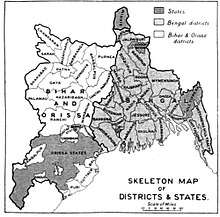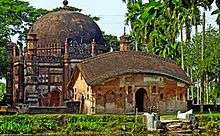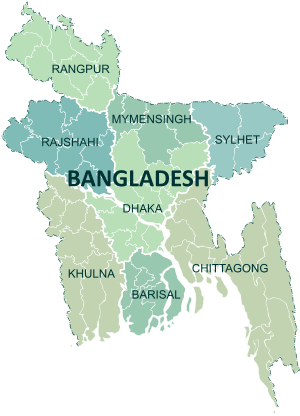Kishoreganj District
| Kishoreganj কিশোরগঞ্জ | |
|---|---|
| District | |
 Location of Kishoreganj in Bangladesh | |
| Coordinates: 24°26′00″N 90°47′00″E / 24.4333°N 90.7833°ECoordinates: 24°26′00″N 90°47′00″E / 24.4333°N 90.7833°E | |
| Country |
|
| Division | Dhaka Division |
| Area | |
| • Total | 2,731.21 km2 (1,054.53 sq mi) |
| Population (2011 census) | |
| • Total | 2,911,907 |
| • Density | 1,100/km2 (2,800/sq mi) |
| Demonym(s) | Kishoreganji, Kishoregonji |
| Literacy rate | |
| • Total | 40.3% (2011 census)[1] |
| Time zone | UTC+6 (BST) |
| Postal code | 2300 |

Kishoreganj (Bengali: কিশোরগঞ্জ) is a district in central Bangladesh. It is a part of the Dhaka Division. Earlier it was a subdivision (Upazilla) under the Mymensingh district. Kishorganj was made a separate district due to Mymensingh dominion suppression. Because Mymensingh District economic growth was remarkable than the capital Dhaka. So to suppress Mymensingh, Greater Mymensingh was separate from their 7 out of 6 Upazilla Kishorgonj, Tangail, Sherpur, Jamalpur, Netrokona( Presently known as District). [1] from Mymensingh. The district consists of four municipalities, 13 upazilas, 105 union parishads, 39 wards, 145 mahallas, 946 mouzas and 1775 villages.
Administration
- Deputy Commissioner: Md Sarwar Murshed Chowdhury
- Additional Deputy Commissioner (Overall): Tarfdar Md. Aktar Jamil
- Additional Deputy Commissioner (Tax): Dulal Chandra Sutradhar
- Additional Deputy Commissioner (Education and Information and Communication Technology): Golam Mohammad Bhuiyan
- Additional District Magistrate: Alamgeer Hosain
Subdistricts/Upazilas
| No. | Upazila | Pourasava | Union | Mouza | Mahalla | Village |
|---|---|---|---|---|---|---|
| 1 | Kuliarchar Upazila | 1 | 6 | 46 | 37 | 97 |
| 2 | Hossainpur Upazila | 1 | 6 | 73 | 16 | 90 |
| 3 | Pakundia Upazila | 1 | 9 | 97 | 25 | 149 |
| 4 | Kishoreganj Sadar Upazila | 1 | 11 | 107 | 84 | 219 |
| 5 | Bajitpur Upazila | 1 | 11 | 92 | 28 | 195 |
| 6 | Austagram Upazila | 0 | 8 | 59 | 0 | 72 |
| 7 | Karimganj Upazila | 1 | 11 | 85 | 17 | 185 |
| 8 | Katiadi Upazila | 1 | 9 | 95 | 20 | 160 |
| 9 | Tarail Upazila | 0 | 7 | 76 | 0 | 105 |
| 10 | Itna Upazila | 0 | 9 | 86 | 0 | 116 |
| 11 | Nikli Upazila | 0 | 7 | 43 | 0 | 132 |
| 12 | Mithamain Upazila | 0 | 7 | 59 | 0 | 137 |
| 13 | Bhairab Upazila | 1 | 7 | 32 | 29 | 88 |
Religion
The district of Kishoreganj contains 3,980 mosques, 530 temples and seven churches.
Places of interest
Kishorganj is a place of the creed of respectively Sanatana and Loukik Islam. Both Meghna and Brahmaputra river have contributed to its existence. Many traditional rituals are observed every year in Kishoreganj. Among them Kurikhai Mela is one of the most celebrated fair. It is a shrine-oriented festival. It is held every year on the last Monday of the month of Magh. The shrine is situated in Katiadi thana. The notable Shamsuddin Aulia, one of the fellow of Hajrat Shahjalal, died in this particular place.
Jangalbari Fort
Jangalbari Fort is situated in Jangalbari village of Karimganj Upazila.[2] It was once a strong outpost of the Bengal Ruler Isa Khan. Isa Khan erected several structures inside the fort area. This fort was severely damaged by the great earthquake in 1897. Isa Khan's descendants still live in this village. Currently the fourteenth descendant of Isa Khan, Dewan Amin Dau Khan, lives in the fort.[3]
Egarosindur
Egarosindur (Bengali: এগারসিন্ধুর) is a village in Kishoreganj. The village is situated on the east side of the river Brahmaputra. The name of this village is found in the Akbornama by the historian Abul Fazal. There is a debate among historians about the history of Egarosindur. Some engraved silver coins, iron-axes, lances and bows and arrows were discovered there presumed to be from the 10th century BC. Historians also believe that Egarosindur was inhabited since 1000 BC, i.e. the time of the Murza. There lived many tribals named Koch and Hajong. Egarosindur was a centre of trade and commerce.

In 380 AD Egarosindur was under the reign of Dobak state. After that this region was reigned by the King of Kamarupa. Another historical analyses prove that in the 8th century Egarosindur was an important river port where Muslim traders exported and imported their product with Rome and Paris. In the 10th century Egarosindur was under the control of Azhaba, a king of Hazradi. Azbaha triumph over this land by defeated King Botong. But after some years Azbaha was beaten by Bebuid Raza and Bebuid Raza was the first popular king of this land. In his time, Egarosindur was reborn again. He built spectacular palaces, forts, big canals, temples etc.
In the second part of the 10th century King Srishochandra controlled this land. After that this area might be governed by Shen king and then it is included with the land of Kamarupa. In the beginning of 14th century the king of Goura, Firoz Shah succeed to win Egarosindur. In 1338 Sultan Fakruddin Mubarak Shah take the authorization of this ancient land. It was seemed that when Sultan was in a critical position, he took shelter in Egarosindur. In 1577 Isa Khan declared Egarosindur a sovereign state. In his age this place appeared as a remarkable place of trade and commerce. In the fort of Egarosindur there held a massive battle between Isa Khan and Mansingh, the general of Akbar. But in the battlefield Mansingh was greatly impressed by the boldness and hospitality of Isa Khan. In one stage when they carried out a duel, Mansingh's sword broke down. Isa Khan did not take his life and most surprisingly he offered his own sword to Mansingh. He said, "I could not kill any helpless person". And then they made an agreement in the battlefield. Akbar granted Isa Khan a jaigir lease over 22 pargonas. After Isa Khan, Egarosindur as a distinct entity was again lost to history. In the reign of Shahjahan in 1638, the king of Assam attacked Egarosindur. Though he was not competent to defeat the warrior of Shahjahan, he destroyed this land ruthlessly when he fled from the battlefield.
Shah Mahmud Mosque
It is an attractive building at Egarosindur may be dated sometime around 1680AD. The mosque stands at the back of a slightly raised platform,which is enclosed by a low wall with a gateway consists of an oblong structure with do-chala roof. The mosque proper is a square structure, 5.79m a side in the inside,and is emphasized with octagonal towers on the four exteriors angles. All these towers shooting high above the roof and terminating in solid kiosks with cupolas,were originally crowned with kalasa finials,still intact in the southern one.The western wall accommodates inside three mihrab –the central one semi –octagonal and the side ones rectangular.The central doorway and central mihrab are larger than their flanking counterparts. The mosque has four axially projected frontones, each corresponding to the centrally located doorways and the central mihrab. The parapets and cornices are horizontal in the usual Mughal fashion.
All the mihrabs are enriched with terracotta decoration. The mihrabs are arched having cuspings in their outer faces. The pilasters,supporting the mihrab arches, show a series of decorated bands topped by a frieze of petals. The spandrels of these arches,though now plain must have been originally enriched with terracotta plaques. Above the rectangular frame of the central mihrab there is a row of arched-niches filled with varieties of small trees containing flowers. The mosque should specially be noted for its four axially projected frontons with bordering ornamental turrets, a device which must have been borrowed from the four axial iwan-type gateways of the Persian influenced north Indian Mughal standard mosques of Fathpur,Agra and Delhi.
Sadi Mosque
Another structure of Egarosindur, is one of the best-conserved monuments in the country. A pertain inscription tablet, fixed over the central mihrab, record that the mosque was built in 1062 AH (1652 AD) by one Sadi, son of Shaikh Shiroo, during the reign of Shahjahan.
Measuring 25 ft a side, the single-domed square mosque was built on a raised piece of land. There are three arched entrances in the east,and one each in the middle of the north and the south sides.The central archway,which is larger,is set within a slightly projected rectangular frame,but the flanking archways are contained within slightly recessed rectangle.The qibla wall is recessed with three semi-octagonal mihrabs,which correspond to the three eastern doorways.The mosque represents a happy blending of Mughal elements with the Sultanate architectural traits characteristic of Bengal.
Fort of Isa Khan
The remain fort is still visible in a spot near the site of Sadi mosque.In this fort Isa Khan was fought against Manshingh, the general of Akbar. Recently some valuable antiques are also found in this place,which bear the attractive history of this legendary place.
Mazar (grave yard) Sharif
In Egarosindur, many pious and kind religious leader came here for inviting people into the light of Islam.Some of them named-Fakir Garibullah Shah (RH), Syed Ahmed Rumi (RH), Nigrin shah(RH) and so on. Their mazars are situated in this village. The Mazar of Garibullah shah(RH) is in a hill like higher position.People treat their mazar with great respect. But it is a matter of great pleasure that there are no superstitions and fanatic activities because the villagers are very much conscious about this matter.
Botanical Garden located by the bank of the river Meghna.
Fairy tales
As it is an ancient place, there are many fairy tales which have become popular in this village. There are tales about the big pond of Bebuid Raza and his wife, two canon of Isa Khan and so on.
Rivers
- Old Brahmaputra
- Meghna,
- Kalni
- Dhanu
- Ghorautra
- Baurii
- Narasunda
- Piyain
- Singuya
Main depressions
- Humaipur (Bajitpur),
- Somai (Nikli)
- Barir (Mithamain)
- Surma Baula (Nikli)
- Tallar Haors (Nikli-Bajitpur-Austagram).
Newspapers
Dailies
- Daily Ajker Desh
- Grihakon
- Bhatir Darpan
- Pratahik Chitra
Online Dailies
Weekly
- Aryagaurava (1904)
- Kishoreganj Bartabaha (1924)
- Akhter (Urdu, 1926)
- Kishoreganj Barta (1946)
- Prativa (1952)
- Natun Patra (1962)
Fortnightly
- Narasunda (1981)
- Grambangla (1985)
- Sristi (1986)
- Sakal (1988)
- Suchana (1990)
- Kishoreganj Parikrama (1991)
- Manihar (1991)
- Kishoreganj Prabaha (1993)
- Bibarani (Kuliarchar 1993)
Education
- Shahid Syed Nazrul Islam Medical College,
- Kishoreganj Polytechnic Institute,
- Jahurul Islam Medical College and Hospital,
- Abdul Hamid Medical College and Hospital,
- Bajitpur Degree College
- Gurudayal Government College, est. 1943
- Ishakha International University Bangladesh est. 2012 (https://www.facebook.com/iiub.edu.bd)
- Walinewaz Khan College, est. 1982
- Karimganj Gov. Collage
- Mithamain College, est. 1991
- Poura Mahila College, est. 1992
- Gochihata College, est. 1993
- Pakundia Degree college, est. 1965
- Pakundia Adarsha Mohila Moha Bidyaloi
- Katiadi College
- Abdul Mannan Mohila College
- Aftab uddin school & college
- Hazi Asmat College, Bhairab
- Zillur Rahman Mahila College, Bhairab
- Rafiqul Islam Mahila College, Bhairab.
- Shaheed ala Uddin high school, mirjapur.
- Charkawna Bahumukhi High School, Pakundia
Notable people
- Upendrakishore Ray Chowdhury (1863-1915) - Authors, painters
- Trailokyanath Chakravarty (1889 - 1970) - Indian revolutionary.
- Nirad C. Chaudhuri (1897-1999) - Indian Bengali−English writer and man of letters.
- Debabrata Biswas (1911 - 1980) - Rabindra Sangeet Artist
- Prabodh Chandra Goswami (1911 - 1987) - Educationists
- Abul Fateh (1924 - 2010) - Diplomats and politicians.
- Syed Nazrul Islam, (1925- 1975) - 1st Vice President of Bangladesh.
- Jahurul Islam (1928 - 1995) - Industrial entrepreneur
- AFM Alim Chowdhury (1928 - 1971) was an eye doctor and intellectual.
- Zillur Rahman (March 9, 1929 - March 20, 2013) - Former President of Bangladesh and a prominent politician.
- Abdul Hamid (born January 1, 1944) - The current President of Bangladesh.
- Ivy Rahman (born July 7, 1944 - death: 24 August 2004) - A Member of Parliament and former Politician
- Anandamohan Bose
- Syed Ashraful Islam (born 1952) - Minister of Public Administration of Bangladesh Government.
- Ilias Kanchan (born 24 December 1956) - Distinguished hero of Dhaka movie
- Shah Abdul Hannan (born 1 January 1939) - Islamic philosopher, educationist, writer, economist and social worker. He was chairman of the National Board of Revenue, chairman of the Anti-Corruption Commission and deputy governor of Bangladesh Bank.
- Md Al-Amin Hossain ( born 07 April 1990) - Bangladesh Student League Leader and Labour and Welfare Officer, Bangladesh High Commission, Singapore.
See also
References
| Wikimedia Commons has media related to Kishoreganj District. |
| Wikivoyage has a travel guide for Kishoreganj District. |
- ↑ "এক নজরে কিশোরগঞ্জ". kishoreganj.gov.bd.
- ↑ "Jangalbari Fort". banglapedia.org.
- ↑ Khodeja Sultana Lopa on The Rich Tradition of Kishoreganj
